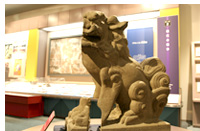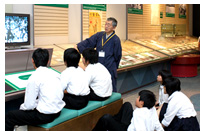| |


|
|
 |
 |
|
Starting in November 1944, U.S. forces intensified their bombing of the Japanese
mainland. In the beginning,only military targets such as bases and munitions
factories were bombed. However, in March of the following year, a shift was made
to target civilians in such large cities as Tokyo, Osaka, Nagoya and Kobe. American
bombers flying in by night at low altitudes dropped heavy payloads of incendiary
bombs which burned down whole sections of these cities.  Then in June, the bombing
of small and medium-size cities and factories commenced. Air raids continued
until just before the end of the War.Not only were many cities heavily damaged
by air raids,but 500,000 people were killed and many others were injured. In
such all-out war, casualties were no longer limited to combatants, but also included
women, children and other civilians. Then in June, the bombing
of small and medium-size cities and factories commenced. Air raids continued
until just before the end of the War.Not only were many cities heavily damaged
by air raids,but 500,000 people were killed and many others were injured. In
such all-out war, casualties were no longer limited to combatants, but also included
women, children and other civilians.
|
 |
Okinawa was the site of the only land battle in Japan during the War. American
forces landed on the Kerama Islands in Okinawa on March 26, 1945, then moved
onto the main island of Okinawa on April 1st. Pitched battles continued on the
ground until the Japanese army's last stand in the south of the island in June.
Unable to depend on the strength of its own soldiers, the Japanese side drafted
civilians into "volunteer corps" and sent them into battle.  As a result,
one in four Okinawans, including elderly residents and children, fell victim
to the War. While the residents were fighting for their homes and lives, the
Japanese authorities were using the Battle of Okinawa to buy time for what they
thought would be the decisive battle of the War-the impending battle for mainland
Japan. As a result,
one in four Okinawans, including elderly residents and children, fell victim
to the War. While the residents were fighting for their homes and lives, the
Japanese authorities were using the Battle of Okinawa to buy time for what they
thought would be the decisive battle of the War-the impending battle for mainland
Japan.
|
 |
At the end of the War, the American forces dropped their newly developed atomic bombs on Hiroshima and Nagasaki in quick succession. The United States claims to have dropped the bombs to expedite Japan's surrender and reduce the number of American casualties. However, the U.S. must have also wished to end the war before the Soviet Union could join in, thus ensuring that America would gain sole control of occupied Japan. The dropping of atomic bombs therefore effectively became the first act of the Cold War, which pitted the United States against the Soviet Union after World War II.
|
| |

Visitors are asked to guess what it is that's holding the flower in the special
attraction case in this section. It turns out that the "vase" is actually
the base of a hand grenade which, like many other pieces of equipment during
the War, was made of ceramics rather than metal. |
|
|
| |
 Plan for Dropping an Atomic Bomb on Kyoto Plan for Dropping an Atomic Bomb on Kyoto |
|
Aerial view of Kyoto taken from a B29 bomber on April 4, 1945, with markings made by American armed forces
personnel to show the downtown area and industrial zones, as well as a circle with a radius of 2400 meters that
indicates the area that would be destroyed if the American forces went ahead with their plan to drop an atomic
bomb on the Umekoji Railroad Garage near Kyoto Station.
(Photograph courtesy of Otis Cary)
|
|
|
| |
|
|
|
 |
|
|
|